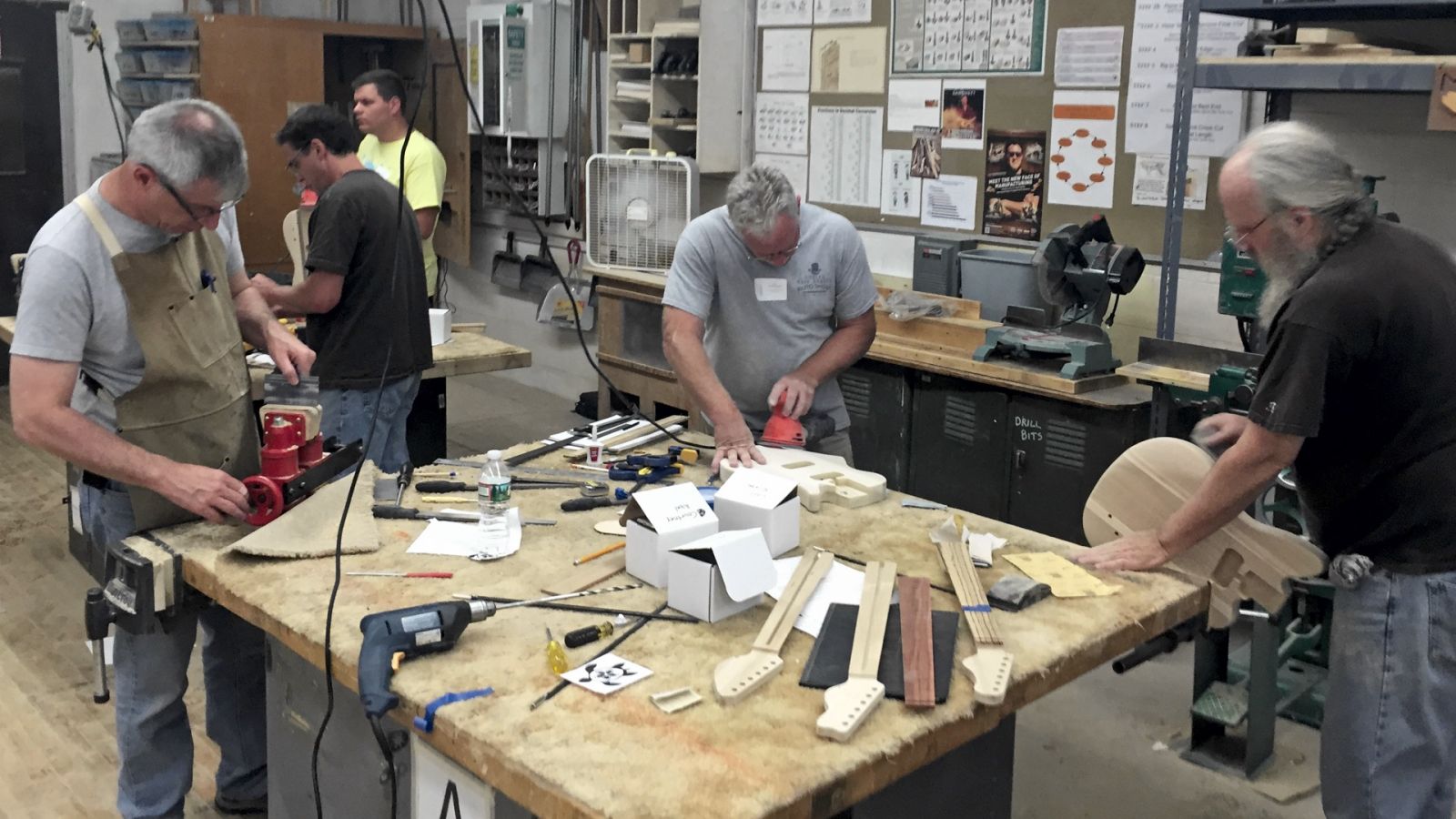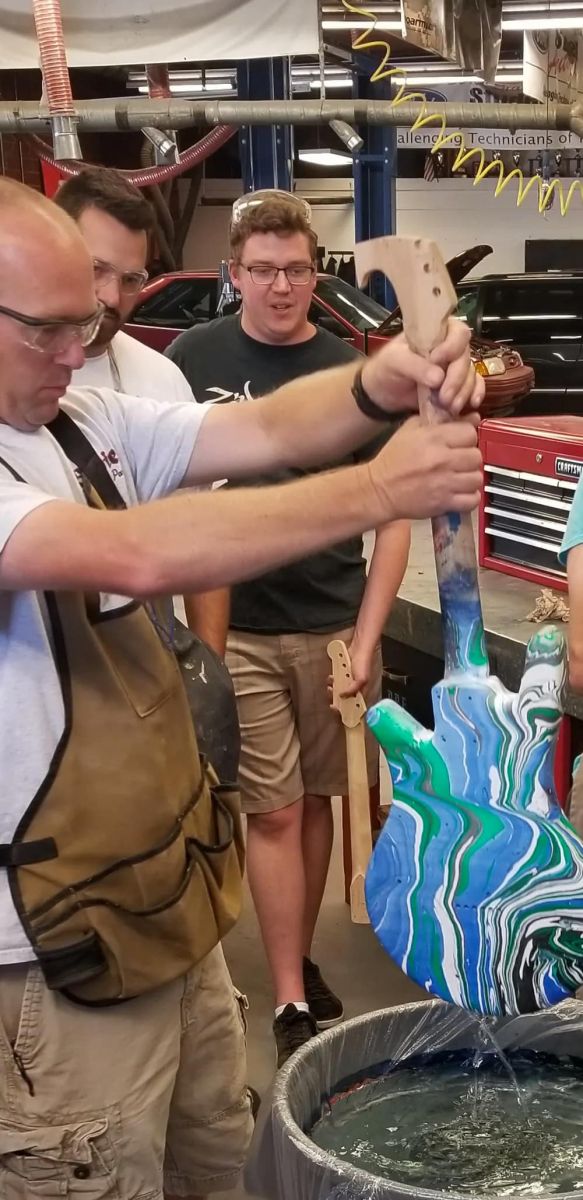
Attention guitarists, luthiers and other stringed-instrument aficionados: February 11 is National Get Out Your Guitar Day, so please act accordingly.
But what if you’re a Purdue student who doesn’t own a guitar? Don’t fret, because Mark French, professor of mechanical engineering technology, teaches MET 34900 (Stringed Instrument Design And Manufacture). During the popular, hands-on course, which French has been teaching since 2008, students break into groups to design and build a working, solid body electric guitar for each team member. What his students might not realize, however, is that they’re learning the fundamentals of manufacturing in addition to guitar-making skills.
“Students think of MET 349 as the guitar-building course, which is fine, but it’s really a manufacturing class,” said French. “I want them to learn manufacturing and they want guitars, so it’s win-win.”
STEM Guitar
When French isn’t surreptitiously teaching manufacturing principles to Purdue students in a guitar-building class, he is working with STEM Guitar, a pedagogical program he co-founded with fellow luthiers that is supported by research funding from Sinclair Community College.
Participants in STEM Guitar – typically teachers of high school, community college and freshman/sophomore university instruction – work with members of STEM Guitar at workshops held across the country. During 50-hour professional development sessions, the teachers learn how to build electric guitars from kits. Upon returning to their schools, those teachers, in turn, teach guitar building to their students as a means of incorporating lessons in science, technology, engineering and math (STEM) in their classes. (STEM Guitar is funded, in part, through the National Science Foundation.)
If that teaching tactic sounds familiar, it might be because it’s similar to the approach French uses in his manufacturing course. Like the Purdue students, the kids in STEM Guitar show up to the class because they want to build an electric guitar. They receive bonus lessons along the way that might spark interest in careers.
 “In addition to learning how to make their guitars, students learn the math behind it,” said French. “They learn how to model a guitar on a CAD (computer-aided design) program and how to use the computer-controlled router to make that part they drew. That is essentially how all modern manufacturing works. The final product happens to be a guitar but the process is not unique. It’s what engineers do.”
“In addition to learning how to make their guitars, students learn the math behind it,” said French. “They learn how to model a guitar on a CAD (computer-aided design) program and how to use the computer-controlled router to make that part they drew. That is essentially how all modern manufacturing works. The final product happens to be a guitar but the process is not unique. It’s what engineers do.”
Beyond engineering, students also learn about acoustics, geometry, structural dynamics, material properties, physics, electronics and project management, but French says STEM Guitar can incorporate just about any subject that teachers bring to class. For example, if students want to learn biology, teachers can discuss the trees that are used for the wood. If instructors want to teach chemistry, they’re in luck because French has broken down the chemistry used in wood finishes. Mathematics are involved because “if you want to lay out a guitar neck, the frets need to go in the exact, right place.”
And what happens when students make a mistake in class?
“They learn problem-solving skills,” said French. “And that’s one of the soft skills that’s in such demand by companies. Once students learn that most building problems are solvable, they can calmly look for solutions rather than having to treat it like a crisis. Our motto for the class is ‘It’s just wood – we can fix it.’”
Since 2009, the National STEM Guitar Project has recruited more than 450 STEM educators across 48 states, with an additional 500 faculty exposed through national education conferences. Those teachers have impacted the lives of more than 20,000 students. Granted, not every student has gone on to work at NASA, but that’s not always the point.
“We’ve had teachers tell us STEM Guitar had made the difference for their students who had been considering dropping out of school,” said French.
STEM Guitar, now unplugged
This year, STEM Guitar is expanding their "product line." In addition to teaching the design and building of electric guitars, instructors are teaching students how to build acoustic guitars.
“Acoustics are a lot harder to make, so we want them to have participated in the electric (workshop) first, and get the basics down,” said French.
From high school students to war veterans
STEM Guitar recently broadened its student base by reaching out to veterans.
“Some of our veterans are facing some real challenges and they need a sense of success. Once they’ve done this, they realize they’ve got some real abilities that they weren’t aware of, and maybe there’s more for them to discover,” said French. “And in a couple of cases, STEM Guitar has taught them job skills. They can start working in the guitar world, doing repairs and supporting themselves.”
Minding the bottom line
Each guitar-building kit costs STEM Guitar more than $200 to create. Some schools and organizations sell completed guitars to fund the program. Most rely on financial donations and class sponsorships.
For more information on STEM Guitar, visit guitarbuilding.org.
Mark French recently wrote about STEM Guitar in “The Conversation US,” an independent, nonprofit publisher of commentary and analysis, authored by academics and edited by journalists for the general public. His article was picked up by news outlets across the country, including in California, Colorado, Alaska and Connecticut.
